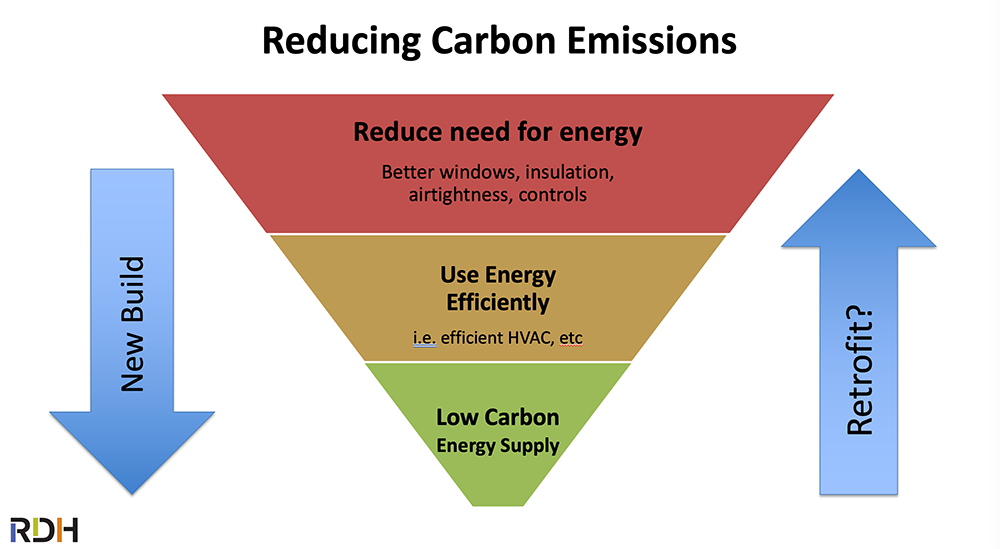Net Zero Deadlines Loom for Boston's Big Buildings

BERDO Brings Implications for Construction and Retrofit
The Boston City Council's recent amendment to the Building Energy Reduction and Disclosure Ordinance (BERDO), known as BERDO 2.0, will require large existing buildings to move from energy reporting to net zero greenhouse gas emissions by 2050. The BSA, with sponsorship from ROCKWOOL and the cooperative support of the Building Enclosure Council and Committee on the Environment Knowledge Communities, recently hosted John Straube, PhD, PEng, principal and senior building science specialist at RDH Building Science, to discuss implications for both new construction and retrofits of large buildings in Boston.
As of 2023, building owners and managers need to report actual energy consumption for non-residential buildings over 20,000 sq. ft., residential buildings with 15 or more units, and any parcel with multiple buildings that add up to 20,000 sq. ft. or 15 units. These buildings will then need to meet phased carbon emissions limits, according to the building's use type, beginning for most buildings in 2025 and culminating in net zero emissions by 2050. Details are available on the city of Boston's BERDO website.
Straube explains that much like approaches in cities such as Washington, DC, New York, and Seattle, BERDO implementation in Boston begins with the collection of information on the actual energy consumption of buildings of specific uses.
Surprisingly—and to the detriment of real-world energy efficiency achievements—that isn't how prior energy efficiency codes have always worked. "They have this great system in America," says Straube, only half tongue in cheek, "where every month a whole army of people spread out across the land, and they collect meter readings from every building around and then they write it down and send owners a bill." Yet because this voluminous energy consumption data is not shared beyond utility companies and customers, it has not been actionable for policymaking.
Instead, previous regulations have centered on research studies and on outcomes of computer modeling, yielding technologies and techniques that can be incorporated into construction standards. But when actual energy measurements are taken, says Straube, regulators often discover that buildings aren't using less energy than before the codes were adopted.
BERDO, by contrast, uses an almost inverse approach: rather than prescribing specific construction standards without measuring actual energy consumption, BERDO mandates specific levels of measured energy consumption, with little regard for the techniques used to achieve them. Buildings will report energy consumption annually. The ordinance, which covers large buildings comprising 4 percent of Boston's total buildings but addressing 60 percent of citywide carbon emissions, establishes per-square-foot carbon emissions limits based on building types. Allowable limits are reduced in five-year time bands, reaching net zero emissions by 2050. Building owners will face fines of $235 per metric ton of excessive emissions, a painful financial penalty which, as Straube notes, far surpasses the $15 to $50 commonly cited today as a price for carbon offsets.
BERDO's approach of measuring actual energy consumption has implications for how to best achieve carbon reduction. For new construction, Straube points to a notional inverted pyramid consisting of three approaches. Atop the pyramid, with maximal bang for buck, is reduction of the need for energy through measures such as insulation, airtightness, and efficient windows, which are most often part of a building's design and construction. Efficient use of energy occupies a second layer of the pyramid, consisting of measures like more effectual HVAC and water heating, which are often part of a building's operational mechanical systems. Low-carbon energy supply completes the pyramid, entailing things like photovoltaic panels and sourcing energy to clean methods of production. For retrofits, the relative impact of these approaches may be reversed: building design and construction may be largely locked in, and existing mechanical systems may have extended operational lifespans before eventual replacement; energy sourcing may prove more attainable.
But with the enforcement of BERDO limits taking effect in 2025, the time for planning is upon us. Additional resources can be found on Dr. Straube's presentation on YouTube, the city of Boston's BERDO website, and the BSA's Building Enclosure Council and Committee on the Environment Knowledge Communities.

